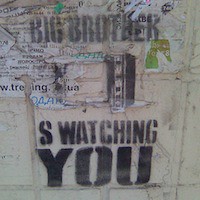Meltdown at TMI (March 28, 1979)

I was born and raised in Central Pennsylvania—Harrisburg, to be exact. My dad was a draftsman for a company then known as R.E. Wright Associates, Inc and that company existed in a city called Middletown. Something else existed in that small town, as well—something that’s still there, today.
Three Mile Island.
Fortunately, I’m way too young to actually remember the panic of March 28, 1979, but I’m fairly certain my parents and my siblings are not. To explain a little about the particular location of these areas from my childhood, from my dad’s office, he had a very clear view of Three Mile Island (or, TMI) and was well within range of the “panic alarm.” My house was on the fringe of the “kill zone.” The “kill zone” technically ended across the street, but I figured, if they were evacuating, chance were we should be, too. It’s not like there was an invisible wall down the center of the street that kept Death from us.
In March of 1979, I was 15 months old. Nuclear power was “the next big thing” that would fuel the world. As such, developments needed to be made. Through development comes accidents and no greater magnitude of accident had ever occurred than the one at the civilian-owned Three Mile Island nuclear power plant on March 28, 1979.
What I was told while I was growing up, was that tons of nuclear waste leaked into the Susquehanna River from Unit-2 of the power plant. So, that meant the fish glowed in the dark and genetic mutations would occur. There was a huge scare that every child born in 1979 and 1980 in the Central PA area would be a mutant of some type. It wasn’t until the early- to mid- 1980’s that the news came out about what really happened there. That news, of course, did not reach me until I started writing this article. Funny how stories you’re told when your four turn out to be completely false when you’re… not.
What really happened, according to the Nuclear Regulatory Commission’s report, started as a failure in the “secondary, non-nuclear section of the plant.” The feedwater pump stopped running, for whatever reason, which meant the generators could not remove the heat. The resulting affect was the turbine automatically shutting down. Of course, that caused the pressure to increase in the nuclear part of the plant, so the emergency valve opened. So far, all the safety procedures worked perfectly. The breakdown began when the valve failed to close once the pressure returned to a more normal level. Further complicating the situation, there was no way for the operators to know the valve was stuck. With the valve stuck open, the coolant began to leak from the core—another feature without proper indication. The operators made an assessment based on the confusing signals of the gauges they did have that, because there was pressure, there had to be enough coolant in the core.
The end result was a literal melting of the reactor core. Extremely hot nuclear fuel leaked out and ruptured the metal fuel containers, then began to melt. After further research and study, officials found that over half of the reactor core had melted in the early stages of the accident.
A meltdown is the worst kind of nuclear accident. In 1979, understanding of what could happen and might be needed in an event of this nature simply did not exist. As a result of the meltdown, however, a number of major changes were put into place—not just at TMI, but within the NRC. Those changes ranged from better and more comprehensive training for the operators to system upgrades at the plant, to a better plan for emergency situations. The worst type of accident brought about the best type of results: change.
Three Mile Island.
Fortunately, I’m way too young to actually remember the panic of March 28, 1979, but I’m fairly certain my parents and my siblings are not. To explain a little about the particular location of these areas from my childhood, from my dad’s office, he had a very clear view of Three Mile Island (or, TMI) and was well within range of the “panic alarm.” My house was on the fringe of the “kill zone.” The “kill zone” technically ended across the street, but I figured, if they were evacuating, chance were we should be, too. It’s not like there was an invisible wall down the center of the street that kept Death from us.
In March of 1979, I was 15 months old. Nuclear power was “the next big thing” that would fuel the world. As such, developments needed to be made. Through development comes accidents and no greater magnitude of accident had ever occurred than the one at the civilian-owned Three Mile Island nuclear power plant on March 28, 1979.
What I was told while I was growing up, was that tons of nuclear waste leaked into the Susquehanna River from Unit-2 of the power plant. So, that meant the fish glowed in the dark and genetic mutations would occur. There was a huge scare that every child born in 1979 and 1980 in the Central PA area would be a mutant of some type. It wasn’t until the early- to mid- 1980’s that the news came out about what really happened there. That news, of course, did not reach me until I started writing this article. Funny how stories you’re told when your four turn out to be completely false when you’re… not.
What really happened, according to the Nuclear Regulatory Commission’s report, started as a failure in the “secondary, non-nuclear section of the plant.” The feedwater pump stopped running, for whatever reason, which meant the generators could not remove the heat. The resulting affect was the turbine automatically shutting down. Of course, that caused the pressure to increase in the nuclear part of the plant, so the emergency valve opened. So far, all the safety procedures worked perfectly. The breakdown began when the valve failed to close once the pressure returned to a more normal level. Further complicating the situation, there was no way for the operators to know the valve was stuck. With the valve stuck open, the coolant began to leak from the core—another feature without proper indication. The operators made an assessment based on the confusing signals of the gauges they did have that, because there was pressure, there had to be enough coolant in the core.
The end result was a literal melting of the reactor core. Extremely hot nuclear fuel leaked out and ruptured the metal fuel containers, then began to melt. After further research and study, officials found that over half of the reactor core had melted in the early stages of the accident.
A meltdown is the worst kind of nuclear accident. In 1979, understanding of what could happen and might be needed in an event of this nature simply did not exist. As a result of the meltdown, however, a number of major changes were put into place—not just at TMI, but within the NRC. Those changes ranged from better and more comprehensive training for the operators to system upgrades at the plant, to a better plan for emergency situations. The worst type of accident brought about the best type of results: change.
You Should Also Read:
TMI Factsheet
TMI Information at the Smithsonian

Related Articles
Editor's Picks Articles
Top Ten Articles
Previous Features
Site Map
Content copyright © 2023 by Christa Mackey. All rights reserved.
This content was written by Christa Mackey. If you wish to use this content in any manner, you need written permission. Contact Lane Graciano for details.







